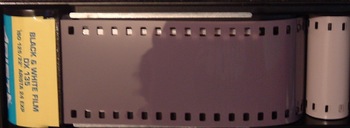
Back Film Afrikaans شريط تصوير ضوئي Arabic Фотографски филм Bulgarian আলোকচিত্রগ্রাহী ফিল্ম Bengali/Bangla Pel·lícula fotogràfica Catalan Fotografický film Czech Fotografisk film Danish Fotografischer Film German Φιλμ Greek Photographic film English

Photographic film is a sheet of plastic for recording visual scenes. The plastic has been coated with an emulsion that is sensitive to light. The image is recorded on the emulsion when it is exposed to light. Film is kept in small canisters (boxes) which protect it from the light. A normal photographic film may hold up to 40 pictures.
Once all pictures have been recorded, the film has to undergo a special chemical treatment. This is called developing a film or film processing. That treatment makes the pictures visible (you can see them), and the exposed film is no longer sensitive to light.[1]
Different kinds of films exist. Some require more light to be exposed than others. Some are black and white only; they record no colors. There are also special films which can record infrared light. Photographic film was invented in the 1880s and replaced the earlier dry plate system.
Films also come in different sizes. 35 millimeter film, the most used size, comes in metal cans or canisters, but there are other camera films that come in paper wrappings or in single sheets.
- ↑ Anchell, Steve 2008. The Darkroom Cookbook p.103-105. Elsevier, Oxford. ISBN 978-0-240-81055-3